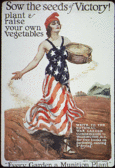First Lady Michelle Obama and White House chef Sam Kass tell the story of the first garden on White House grounds since Eleanor Roosevelt's Victory Garden during World War II. This new garden was planted in the Spring of 2009 with the help of local elementary school children and has yielded a constant supply fresh produce for the First Family and White House events.
White House Announces 2012 Spring Garden Tours
The White House will open its gardens and grounds to visitors on Saturday, April 21st from 9:00AM to 4:00PM, and on Sunday, April 22nd from 9:00AM to 3:00PM Visitors can view the Jacqueline Kennedy Garden, Rose Garden and the South Lawn of the White House. Additionally, the White House Kitchen Garden – the first vegetable garden at the White House since Eleanor Roosevelt’s Victory Garden – will be accessible to tour guests.
These Garden Tours are free and open to the public; however, a ticket is required for all attendees (including small children). The National Park Service will distribute free, timed tickets at the Ellipse Visitor Pavilion located at 15th and E Streets on each tour day beginning at 8:00AM. Tickets will be distributed -- one ticket per person -- on a first-come, first-served basis.
Victory garden's History
In March 1917, Charles Lathrop Pack organized the National War Garden Commission and launched the war garden campaign. During World War I, food production had fallen dramatically, especially in Europe, where agricultural labor had been recruited into military service and remaining farms devastated by the conflict. Pack conceived the idea that the supply of food could be greatly increased without the use of land and manpower already engaged in agriculture, and without the significant use of transportation facilities needed for the war effort. The campaign promoted the cultivation of available private and public lands, resulting in over five million gardens[2] and foodstuff production exceeding $1.2 billion by the end of the war.[3]
Amid regular rationing of canned food in Britain, a poster campaign ("Plant more in '44!") encouraged the planting of victory gardens by nearly 20 million Americans. These gardens produced up to 40 percent of all the vegetable produce being consumed nationally.[4]
It was emphasized to home front urbanites and suburbanites that the produce from their gardens would help to lower the price of vegetables needed by the US War Department to feed the troops, thus saving money that could be spent elsewhere on the military: "Our food is fighting," one US poster read.[5]
One major cause of the food shortages was the forced interment of Japanese-Americans. According to the California Farm Bureau, Japanese farmers were responsible for 40% of the vegetables grown in California valued at over $40 million annually. Japanese farmers were forced to leave about 200,000 acres of farmland. The land was transferred to European immigrants or Americans from the Dust Bowl region. Being new to the California climate, they were unable to match the production of the experienced Japanese farmers. As a result of this food shortage, policies encouraging victory gardens were implemented.[6]
Although at first the Department of Agriculture objected to Eleanor Roosevelt's institution of a victory garden on the White House grounds, fearing that such a movement would hurt the food industry,[7] basic information about gardening appeared in public services booklets distributed by the Department of Agriculture, as well as byagribusiness corporations such as International Harvester and Beech-Nut. The US Department of Agriculture estimates that more than 20 million victory gardens were planted. Fruit and vegetables harvested in these home and community plots was estimated to be 9-10 million tons, an amount equal to all commercial production of fresh vegetables.
Victory gardens were planted in backyards and on apartment-building rooftops, with the occasional vacant lot "commandeered for the war effort!" and put to use as a cornfield or a squash patch. During World War II, sections of lawn were publicly plowed for plots in Hyde Park, London to publicize the movement. In New York City, the lawns around vacant"Riverside" were devoted to victory gardens, as were portions of San Francisco's Golden Gate Park.
In 1946, with the war over, many residents did not plant victory gardens in expectation of greater produce availability. However, shortages remained in the United Kingdom.
The Fenway Victory Gardens in the Back Bay Fens of Boston, Massachusetts and the Dowling Community Garden in Minneapolis, Minnesota, remain active as the last surviving public examples from World War II. Most plots in the Fenway Victory Gardens now feature flowers instead of vegetables while the Dowling Community Garden retains its focus on vegetables.
Since the turn of the 20th to 21st century, there has existed a growing interest in victory gardens. A grassroots campaign promoting such gardens has recently sprung up in the form of new victory gardens in public spaces, victory garden websites and blogs, as well as petitions to both renew a national campaign for the victory garden and to encourage the re-establishment of a victory garden on the White House lawn. In March 2009, First Lady Michelle Obama, planted an 1,100-square-foot (100 m2) "Kitchen Garden" on the White House lawn, the first since Eleanor Roosevelt's, to raise awareness about healthy food.[8]


